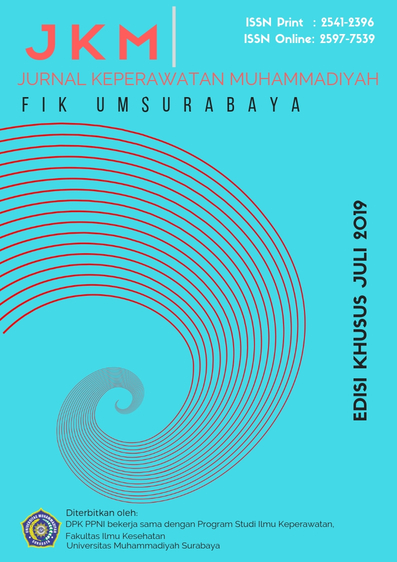Faktor Yang Mempengaruhi Risiko Gangguan Perilaku Anak Dengan Human Immunodeficiency Virus
DOI:
https://doi.org/10.30651/jkm.v4i2.2349Keywords:
Behavioral disorder, Children, HIVAbstract
The number of child HIV patients in Indonesia in 2016 was 1,185 children. In pediatric and adolescent patients with perinatal HIV, the risk of psychological disorders can arise as a direct and indirect result of HIV infection. The direct effect is derived from HIV infection itself and the indirect consequences are caused by things related to HIV status. These problems include emotional, behavioral, cognitive and psychosocial disorders. At present a child's development check is carried out if a problem is suspected and there are no regular inspections. This includes examining the risk of behavioral disorders for children with HIV. Knowing the risk of behavioral disorders in children with HIV aged 6-18 years. The research respondents were outpatients at Poli UPIPI RSUD Dr Soetomo. Patients and guardians who were present were given an explanation and were asked to fill out informed consent as a sign of agreement to become respondents. All patients and guardians who came and met the criteria were taken as research respondents. This research was conducted by filling out a questionnaire regarding risk factors and research instruments. The instrument used was GPPH to assess the risk of behavioral disorders. Statistical analysis with logistic regression showed that the risk factors for hospitalization history (P = 0.031) and parental completeness (P = 0.011) were associated with risk of behavioral disorders. Children who have been hospitalized in the hospital have a possibility of 22,337 times greater risk of behavioral disorders. And children who don't have parents have a 40.586 times greater risk of behavioral disorders. There was a risk of behavioral disorders in children with HIV aged 6-17 years who do not have parents or had been hospitalized.References
Das S, 2009. A study on the emotional and behavioral problems of children living with HIV/AIDS. Department of Psychiatric Social Work, NIMHANS; Bangalore, India
Fox, S., Levitt, P., Nelson, C.A., 2010. How the timing and quality of early experiences influence the development of brain architecture. NIH Public Access 81:28–40.
Grover G, Pensi T, Banerjee T, 2007. Behavioural disorders in 6-11-year-old, HIV-infected Indian children. Ann Trop Paediatr. 27:215–224. PubMed: 17716450
Hua X, C.P. Boyle, D.F. Tate, C.T. Yiannoutsos, R. Cohen, 2013. Disrupted cerebral metabolite levels and lower nadir CD4+ counts are linked to brain volume deficits in 210 HIV-infected patients on stable treatment. Neuroimage Clinic. 3:132-142
Kementrian Kesehatan RI, 2016. Laporan Situasi Perkembangan HIV-AIDS & PIMS di Indonesia April-Juni 2016. Jakarta: Ditjen P2P Kementrian Kesehatan RI
Koenig L.J, Nesheim S, Abramowitz S. 2011. Adolescent with perinataly acquired HIV: emerging behavioural and helath needs for long term survivors. Current opinion in obstetric and gynecology. 23:321-327
McLanahan S, Tach L, Schneider D. The causal effects of father absence. Annual Review of Sociology. 2013;39:399–427.
Nelson J.R., Gregory J. Benner, Douglas Cheney, 2005. An Investigation of the Language Skills of Students With Emotional Disturbance Served in Public School Settings. The Journal of Special Education, 39(2):134-145
Skovdal M, 2012. Pathologising healthy children A review of literature exploring the mental health of HIV-affected children in sub –saharan Africa. Transcultural Psychiatry. 49(3-4) 461-491
Soedarmo SSP dkk, 2015. Buku Ajar Infeksi dan Pediatri Tropis Edisi Kedua. Jakarta: Ikatan Dokter Anak Indonesia
Supartini. 2012. Buku Ajar Konsep Dasar Keperawatan Anak. Jakarta: EGC
Tadesse AW, Tsehay YB, Belaineh BG, Alemu YB, 2012. Behavioural and emotional problems among children aged 6-14 years on highly active antiretroviral therapy in Addis Ababa: A cross sectional study. Child Behav. 51:189-200
Vranda M.N, S.N. Monthi, 2013. Psychosocial Issues of Children Infected with HIV/AIDS. ndian J Psychol Med. 2013 Jan-Mar; 35(1): 19–22.
Downloads
Published
Issue
Section
License
- Penulis tetap memegang hak atas karyanya dan memberikan hak publikasi pertama kepada jurnal ini yang secara simultan karya tersebut dilisensikan di bawah:Â Creative Commons Attribution-ShareAlike 4.0 International (CC BY-SA 4.0)













